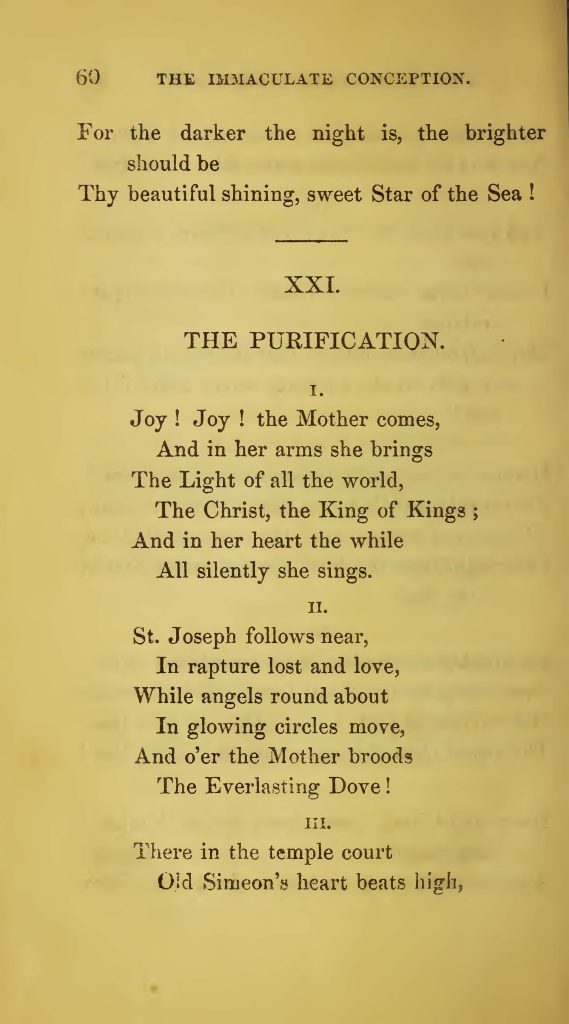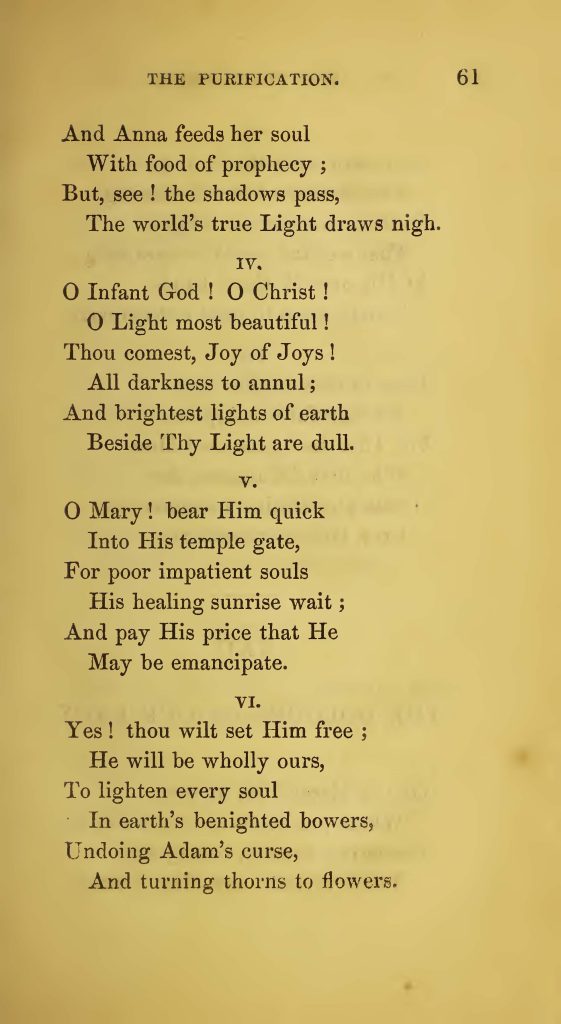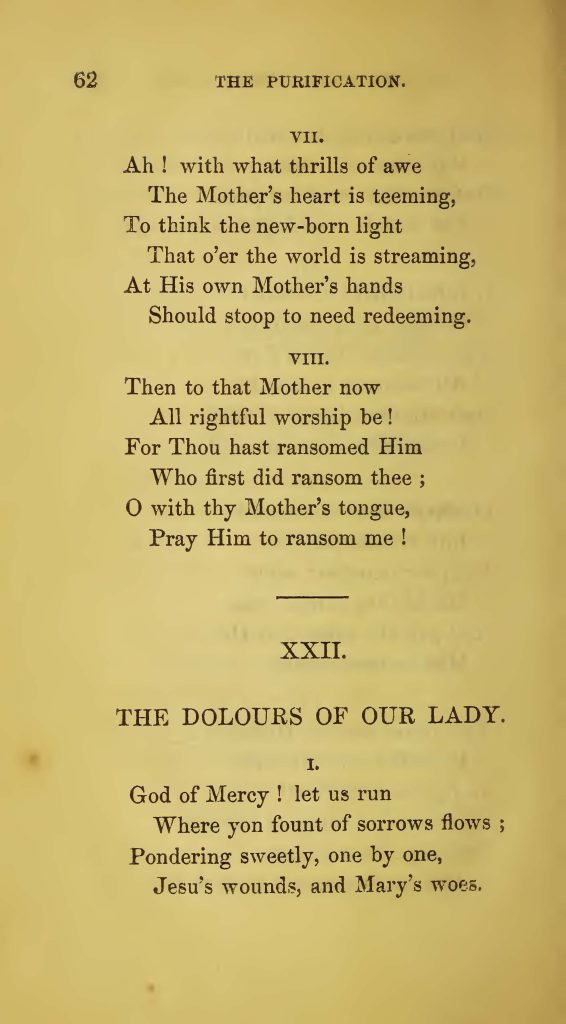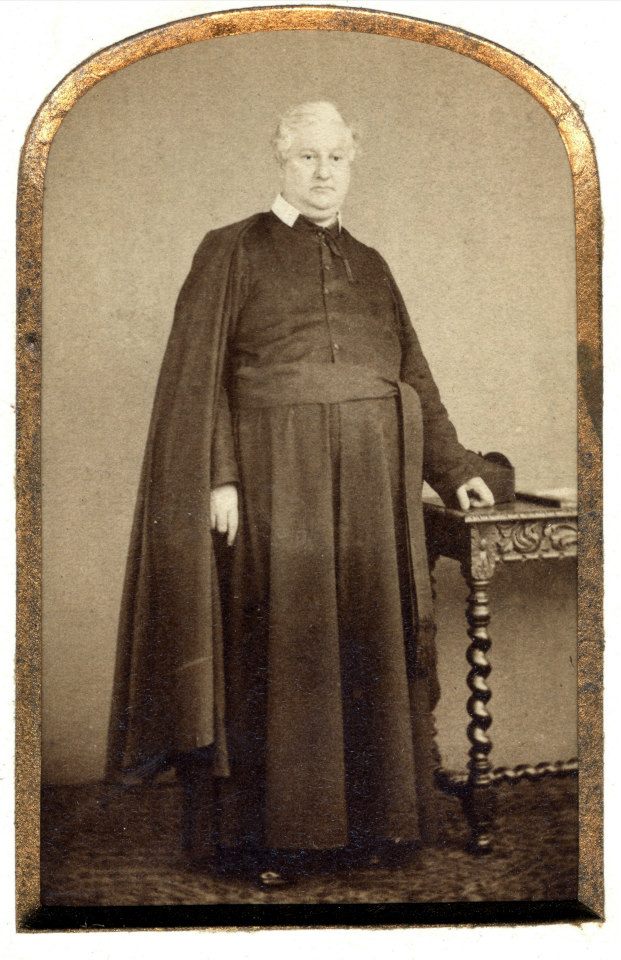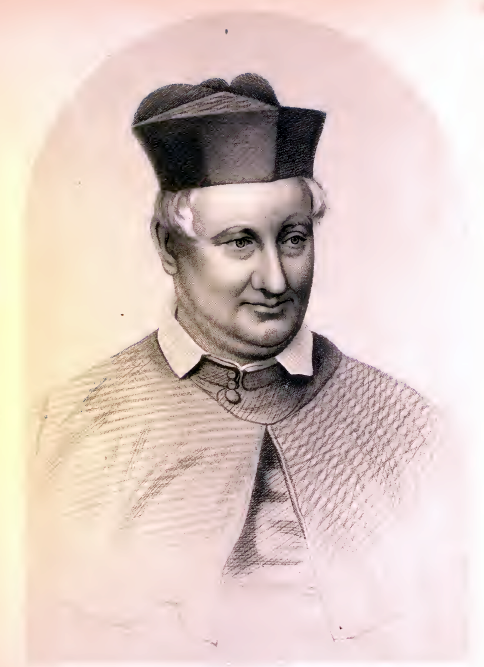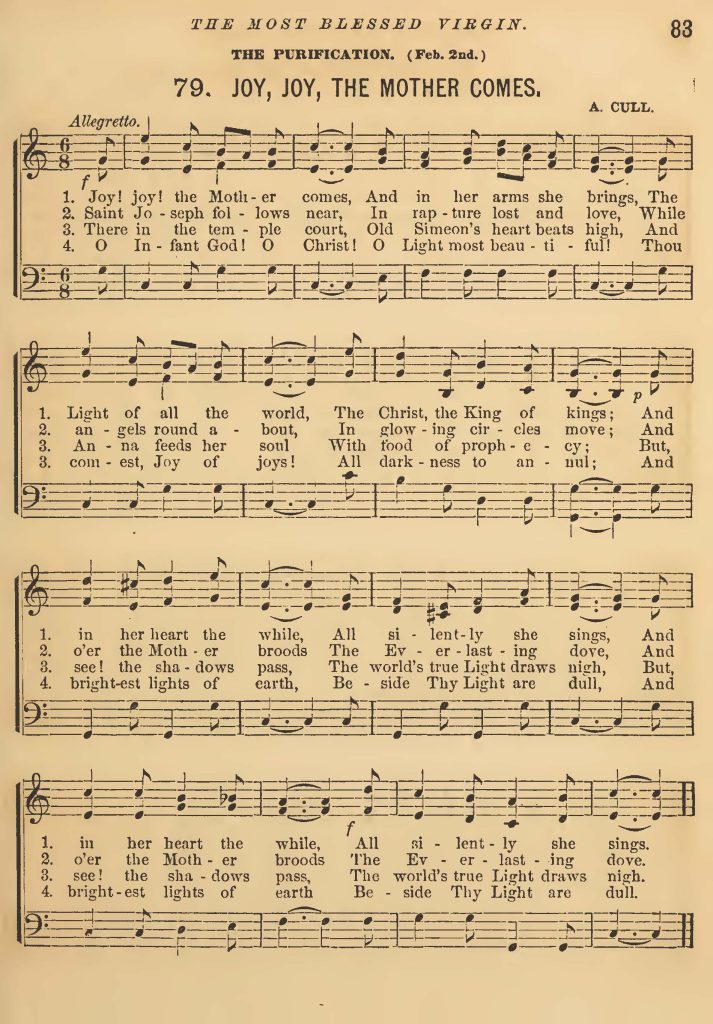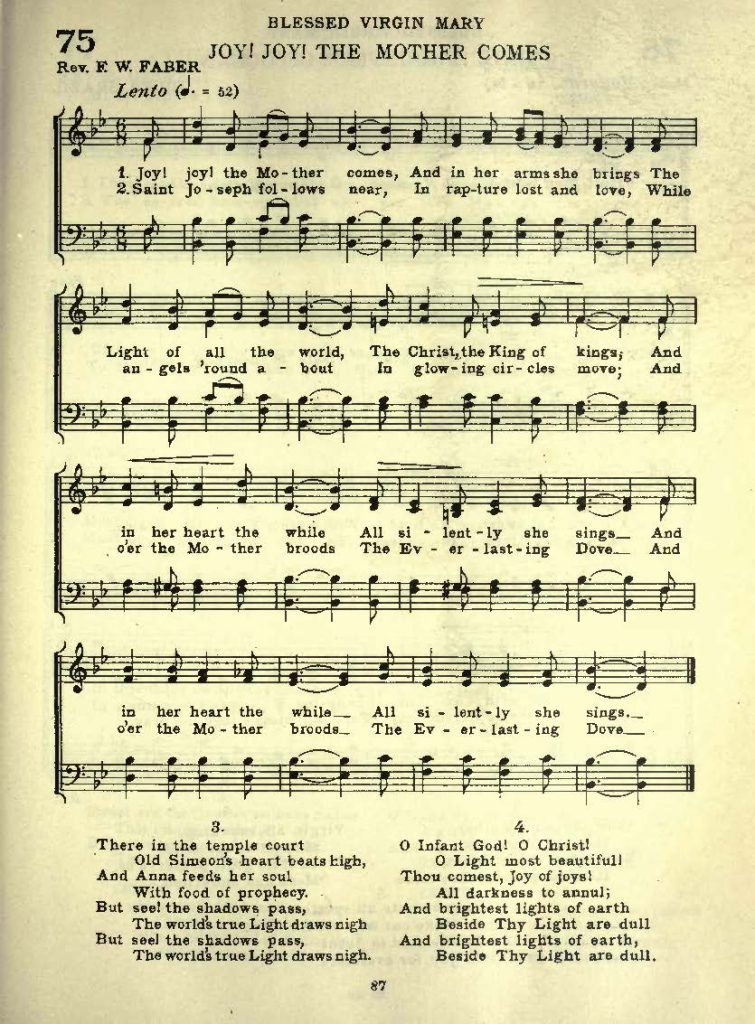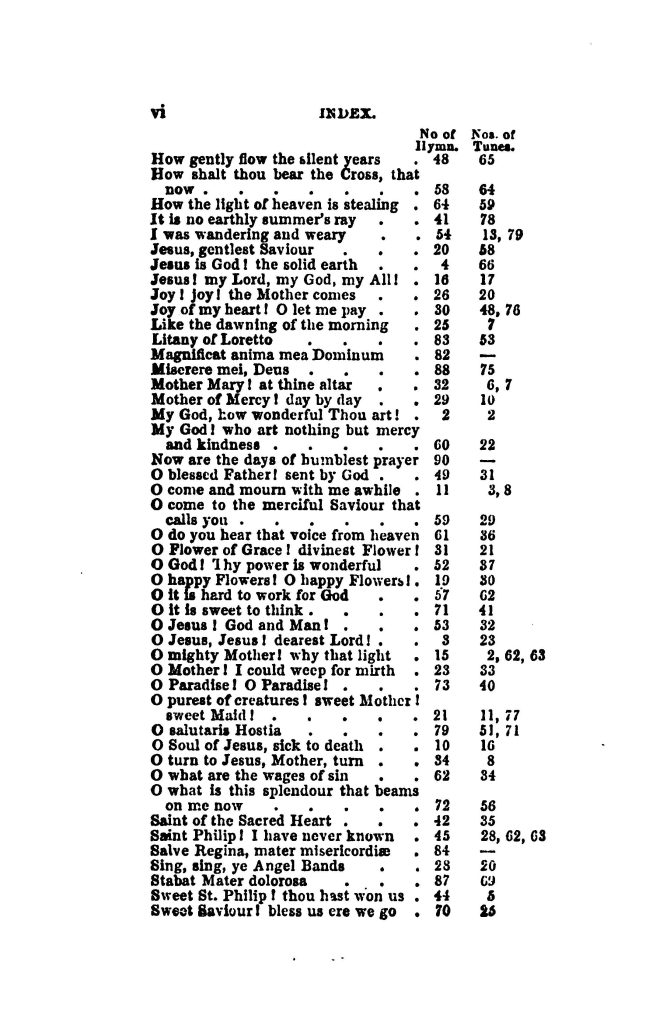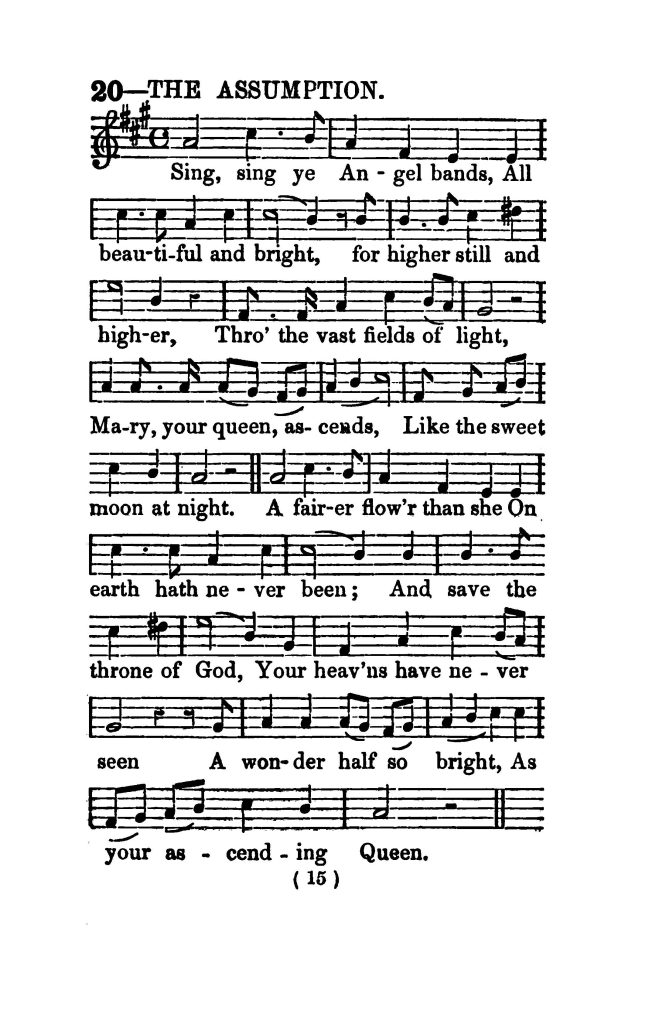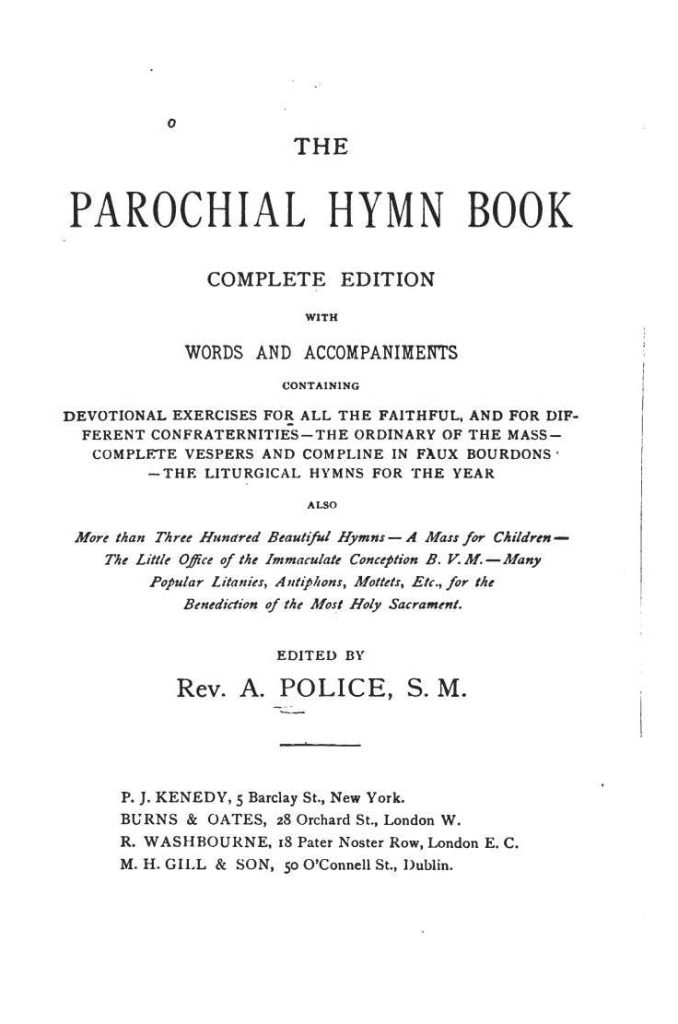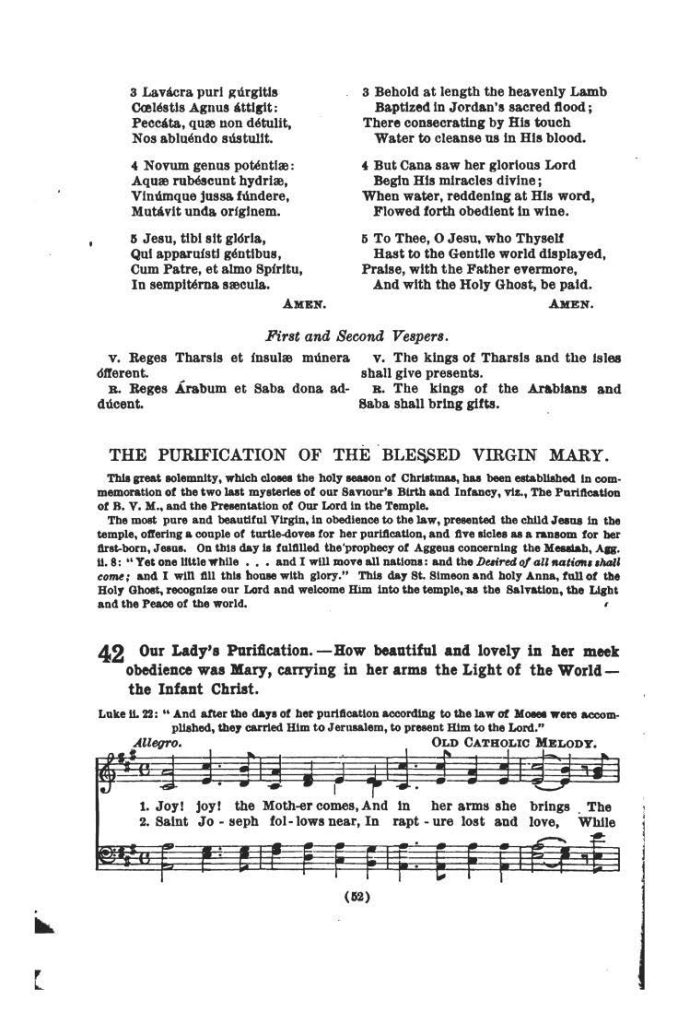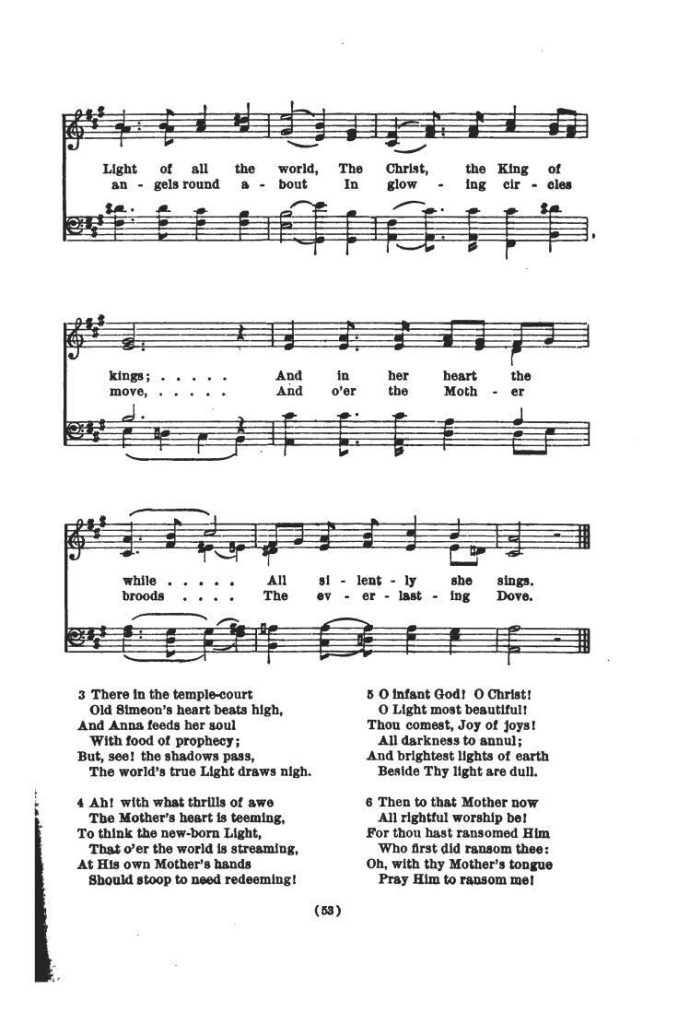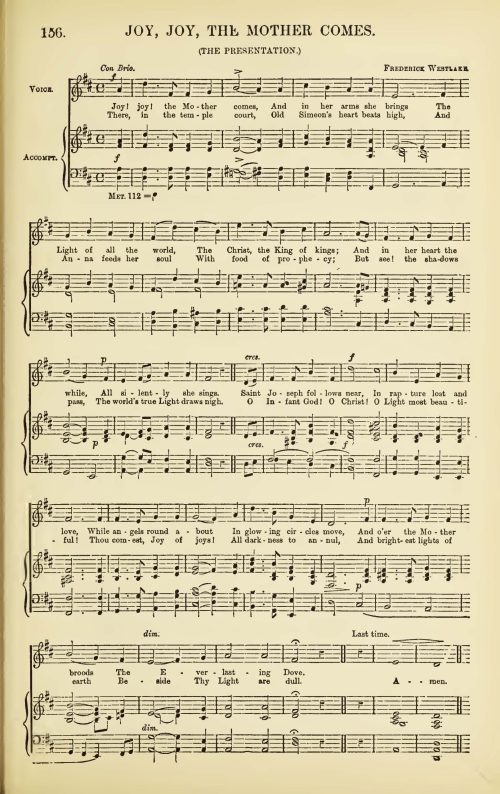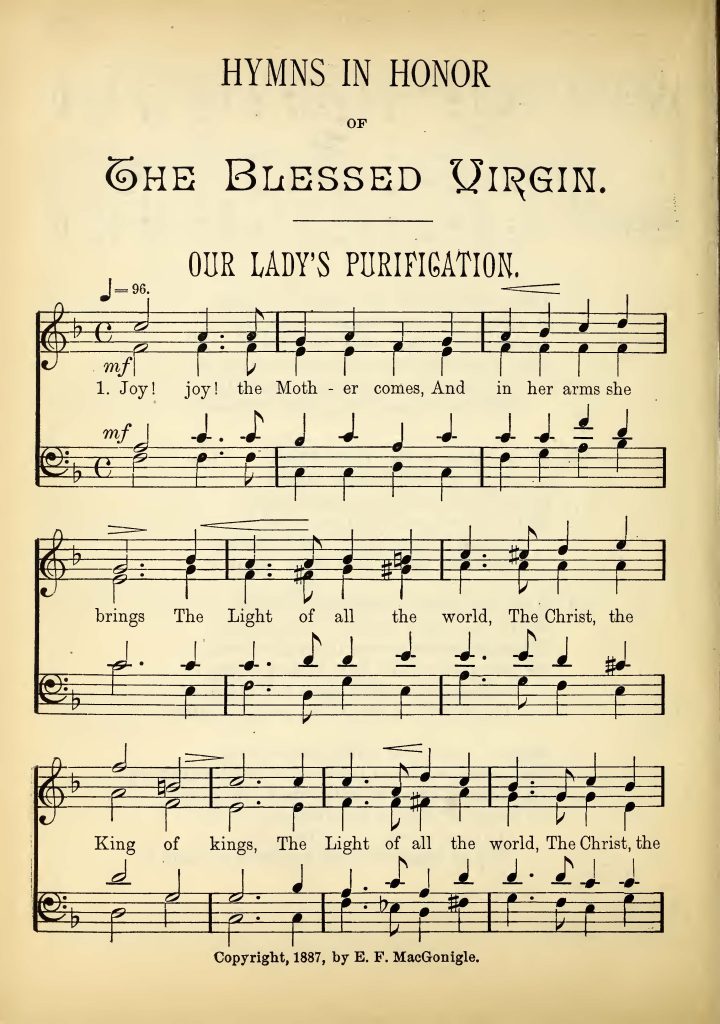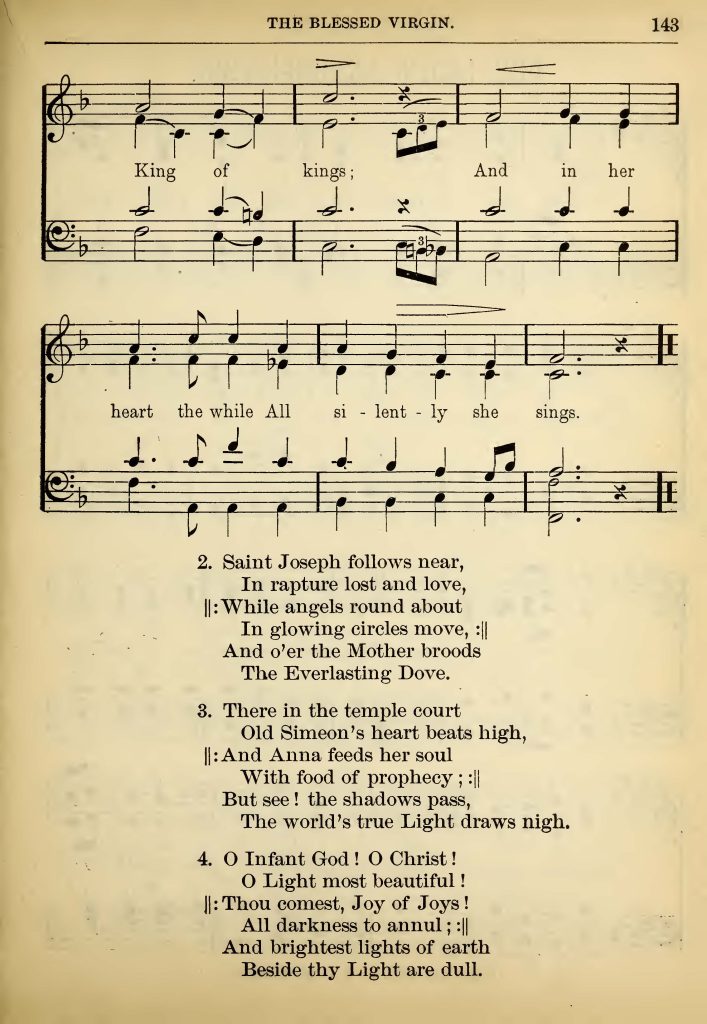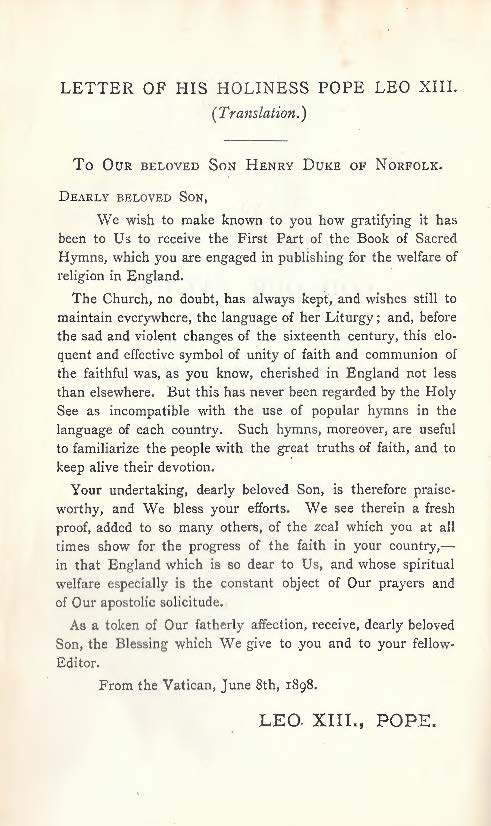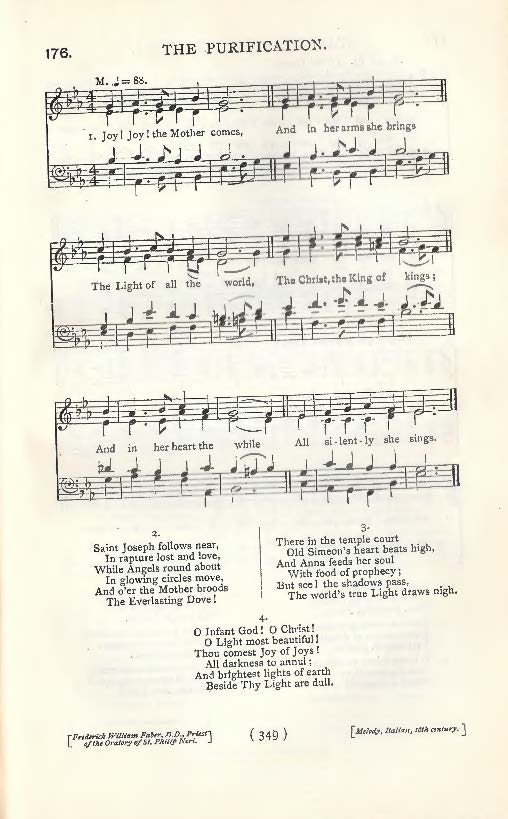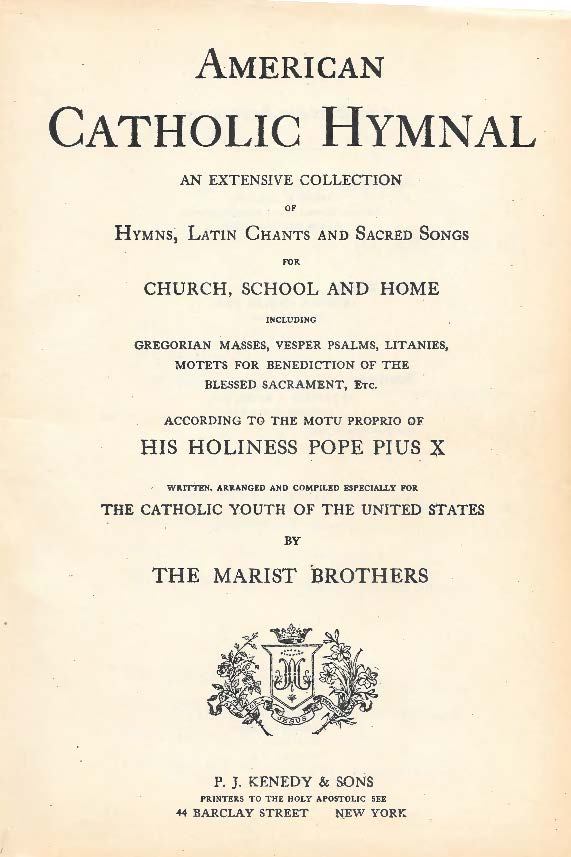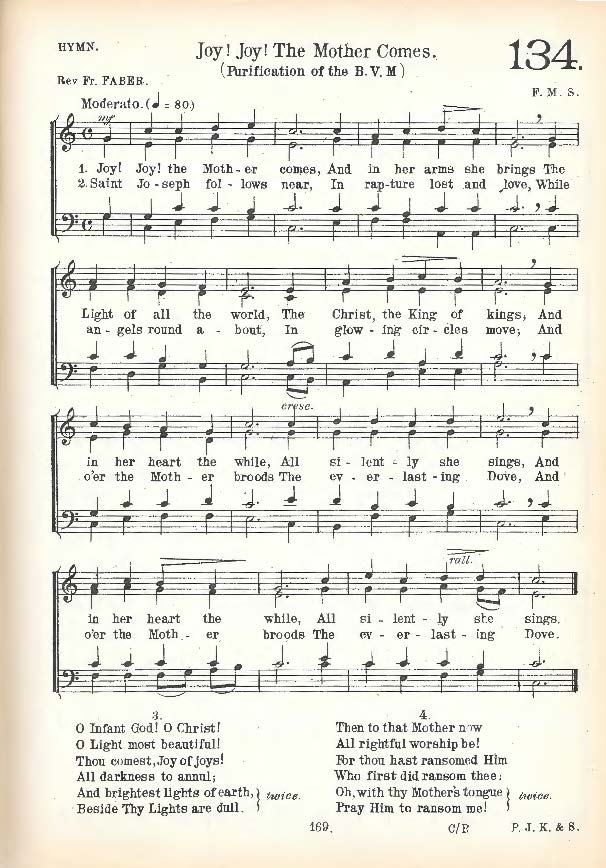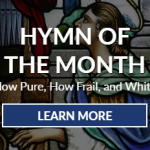Father Frederick William Faber (1814-1863) wrote the words of this hymn for the Feast of The Purification. The earliest appearance of this hymn was in the second edition of his JESUS AND MARY hymnal. This collection of hymns was published in 1852 by Richardson and Son of London. The second edition had more than twenty new hymns and was published throughout England and Ireland.
Father Faber began writing hymns in 1848 and the very first two of his hymns, those on Our Blessed Lady and Corpus Christi, were written one night while on retreat during his stay at Scarborough. He wrote these at the request of Father Hutchison who was a close personal friend and whose conversion to Catholicism was in large part due to Father Faber’s instruction’s.
These first hymns and those that followed, eleven in total, were printed in a small collection for the congregation of St. Wilfrid’s in Staffordshire in 1848. More hymns were added, some thirty in total, and they were published in 1849 which was the first edition of Father Faber’s JESUS AND MARY hymnal. More hymns were given in the ORATORY HYMNS published between 1854 and 1860 which had ninety hymns.
These early collections were building to larger volume of one hundred and fifty hymns which corresponded to the Psalter a limit set by Father Faber himself. This complete collection known as HYMNS by Frederick William Faber, was published in 1862. Father Faber’s HYMNS were widely used in Catholic churches and wherever the English language was spoken. They had become universal, being published in England, Ireland, and America. Many of his hymns are to be found in Protestant collections. Among them, Hymns Ancient and Modern, published in 1861 which contain several, and the Hymnal Noted, published in 1851, which contains no less then twenty-four; the chief favorites being, O Come and Mourn With Me Awhile; The Precious Blood; I was wandering and weary; Sweet Savior! Bless us ere we go, and O Paradise! O Paradise!
Father Faber’s HYMNS saw later publications in 1867, 1871, 1880, 1888, and 1894. Some of these publications contained illustrations by artists derived from the LIFE AND LETTER’S of Father Faber published in 1869 but none are a complete collection and contain about ninety hymns each. Those hymns written for the Angels and Saints, the Sacraments, the Faith & Spiritual Life, those written for the Last Things, and a small collection of miscellaneous hymns are missing. Today, only a few of Father Faber’s hymns can be found in mainstream Catholic hymnals and missalettes.
Father Faber’s hymn Joy! Joy! the Mother Comes appeared in the following Catholic hymnals in addition to those mentioned above: THE CATHOLIC YOUTH’S HYMN BOOK, 1871 compiled by the Christian Brothers of New York; the PAROCHIAL HYMN BOOK from 1881 thru 1897 compiled by Father Antoine Police, S.M.; ST. BASIL’S HYMNAL from 1888 through 1925 compiled by the Basilian Fathers of St. Michael’s College in Toronto; ARUNDEL HYMNS, 1905 compiled by the Henry Duke of Norfolk and Charles Gatty; the AMERICAN CATHOLIC HYMNAL, 1913 and 1921 compiled by The Marist Brothers; SELECED CATHOLIC HYMNS, 1930; A DAILY HYMN BOOK, 1932 and 1948 compiled by the Society of St. John the Evangelist.
The Melodies
Six melodies have been found for the hymn. Augustus Cull composed the first melody. He was a German composer and arranger living in New York and was highly active during the American Civil War. His works included polkas, ballads, and various arrangements of hymns and national songs. Most of his compositions were published by Horace Waters, a music publisher living in New York City. The melody appeared in Catholic hymn books from 1871 through 1925.
The second melody appeared in EASY HYMNS AND SONGS published in 1851 for the hymn Sing, Sing Ye Angel Bands, a hymn written by Father Faber for the Feast of the Assumption. EASY HYMNS AND SONGS was compiled by Henri F. Hemy, and copies of this small hymn book are extremely rare. This collection of hymns was designed to introduce hymnody to missions and schools. Later the melody appeared in the ORATORY HYMNS WITH TUNES published in 1854 for both Sing, Sing Ye Angle Bands and Joy! Joy! the Mother Comes as can be seen in the index of hymns. The melody went on and became widely used for Sing, Sing Ye Angle Bands but quietly faded away for Joy! Joy! the Mother Comes. Then a Marist priest, Father Antoine (sometimes Anatole) Police, S.M., introduced the melody once again for Joy! Joy! the Mother Comes and it appeared in his PAROCHIAL HYMN BOOK which saw publications in Dublin, London, and New York between 1881 and 1897.
Frederick Westlake composed a third melody which appeared in the POPULAR HYMN AND TUNE BOOK published in 1868. He was the editor of the hymn book, a convert to Catholicism, and a professor of music at the Royal College of Music in London. He was also an accomplished and prominent pianist who composed several Masses, hymns, and piano pieces. Two of his brothers, Philip and Nathaniel, were also converts to Catholicism.
A fourth melody was found in the SODALIST’S HYMNAL of 1887 compiled by E. F. MacGonigle and published by George W. Gibbons of Philadelphia. E. F. MacGonigle was an editor and composer of the late 19th century. This hymnal was renewed for copyright by Mary A. MacGonigle as widow of the author on January 30, 1915.
A fifth melody was found in the ARUNDEL HYMNS published in 1905. One of the editors Henry, Duke of Norfolk, sent a copy to Pope Leo XIII, for which he received a letter of congratulations and encouragement. This collection of hymns was drawn from English, German, Italian, Spanish, Portuguese, Hungarian, and Bohemian sources. Melodies from ancient and contemporary sources were chosen. Twenty were of Italian origins, several were from Bach, and more than a dozen from Robert Pearsall (1795-1856). Many of the hymns were given more than one melody and so the hymn book holds more melodies than it does hymns. One of the chief characteristics of the hymn book is its information on the old composers and the sources for the melodies. The hymn book did not achieve any great success but would become a source for American editors looking for new material. This melody also appeared in A DAILY HYMN BOOK which was published in 1932 and 1948.
A sixth melody was found in the AMERICAN CATHOLIC HYMNAL published in 1913. The early success of this hymnal which sold more 3,000 copies in the first six months provided the initiative for a later publication in 1921. In the 1913 edition the initials A. C. H. are given as the composer of the melody. These initials also appear for several other hymns and in the 1921 edition the initials were changed to F. M. S., meaning Fraters Maristae a Scholis. The composer of this melody was one the Marist Brothers whose identity remains hidden.
The AMERICAN CATHOLIC HYMNAL represents an important contribution to Catholic hymnody. Perhaps more than any other, the hymnal contains a number of hymns taken from Catholic periodicals that were widely read by Catholics including twenty from the Messenger of the Sacred Heart, the Ave Maria Magazine, the Rosary Magazine, the Catholic Voice, and the Sentinel of the Blessed Sacrament. A large number of Holy Communion hymns that were contributed by Isabel Williams of Boston were highly commended by the editors. A Sister of the Visitation contributed a few hymns under the pseudonym M. S. Pine – Sister Mary Paulina Finn (1842-1935). Several by S. M. X., who in religious life was known as Sister Mary Xavier, and the translations of Monsignor Hugh Thomas Henry, Litt. D., were also used. The 1921 edition contains a full index of authors and sources, and it is quite mesmerizing to read through this index and see those who contributed to this great collection of Catholic hymnodies.
A handful of other hymns were written and composed for the Feast of the Purification / Presentation of the Lord.
From the WREATH OF MARY, 1883
- Soft Breaks the Morn on Zion Hill’s, words, and music by a Sister of Notre Dame (SND)
- Mother of God, unto the Temple Bring, words by a SND, music composed by Homan.
From the ROMAN HYMNAL, 1884
- #129 O Jerusalem Beloved, joyful morn has dawned on thee, words by Christopher Wordsworth (1807-1885).
From ST. MARK’S HYMNAL, 1910 (these two hymns also appeared in the ICEL Resource Collection, 1981)
- #126 Hail to the Lord Who Comes, words by John Ellerton, music composed by F. H. Champneys (1826-1893)
- #127 In His temple now behold Him, words by Henry J. Pye (1827-1903), music harmonized by J. Christoph Bach (1642-1703)
From the YOUNG PEOPLE’S CATHOLIC HYMN BOOK, 1910
- #48 Behold In Mary’s Arms! author unknown, music composed by William E. Bergé.
From the WESTMINSTER HYMNAL, 1912
- #116 O Sion Open Wide Thy Gates, words translated by Father Edward Caswall, music composed by M. Franklin.
From THE NEW CATHOLIC HYMN BOOK, 1924 (also in the HALF A HUNDRED CATHOLIC HYMNS)
- #38 What Joy Rings Out From Skies Above, author unknown, music composed by Louis Bergé.
Reflection
The story of the Purification can easily be found in the verses of Father Faber’s hymn. The requirements of the old Mosaic Law and Mary and Joseph’s fulfillment of the law in the Gospel of Luke (Leviticus 13: 1-8; Numbers 18:15; and Luke 2: 22-39.). In the last phrase of the first verse, And in her heart the while, All silently she sings, I am reminded of the passage, Mary treasured all these things and reflected on them in her heart (Luke 2: 19).
This wonderful hymn is a foreshadowing of Catholic mothers who bring their infants to church for baptism, and the fathers, like St. Joseph follows near. In verses three and four, I see the faith of Simeon and Anna. Simeon had waited his whole life to see the world’s true Light. In verses three and four, I see the faith of Simeon and Anna. Simeon had waited his whole life to see the world’s true Light.
Many of the characteristics of Father Faber’s hymns appear on the surface; but there are others which upon thoughtful investigation and close examination will reveal statements of theology and doctrine illuminating and touching the heart of those who take the time to reflect on the verses.
What can you see?
A special thank you to Peter Meggison producer of the Devotional Hymns Project for allowing me to link to a recording of Joy! Joy! the Mother Comes, sung by the Advent Choir of The Church of the Advent located in Boston’s Beacon Hill section.
Featured below are computer generated sound files. The tempo is approximate but should provide the listener a good sense of what the hymn sounds like. All the hymns are in the public domain. Music directors, if you use any of these selections in your Sunday or weekly music programs and you make a recording, contact the author and I may feature it in the What’s New section of the website.
Having listened to the melodies many times over in preparation of this short write-up, I like the melody that first appeared in EASY HYMNS AND SONGS and later in the PAROCHIAL HYMN BOOK. For me, this melody easy to sing. When I hear it, it invokes the words, and when I see the words, it invokes the melody. These characteristics are the hallmark of a good hymn. I hope one of the melodies featured in this write-up will make its debut in your choir for the Feast of the Purification.

